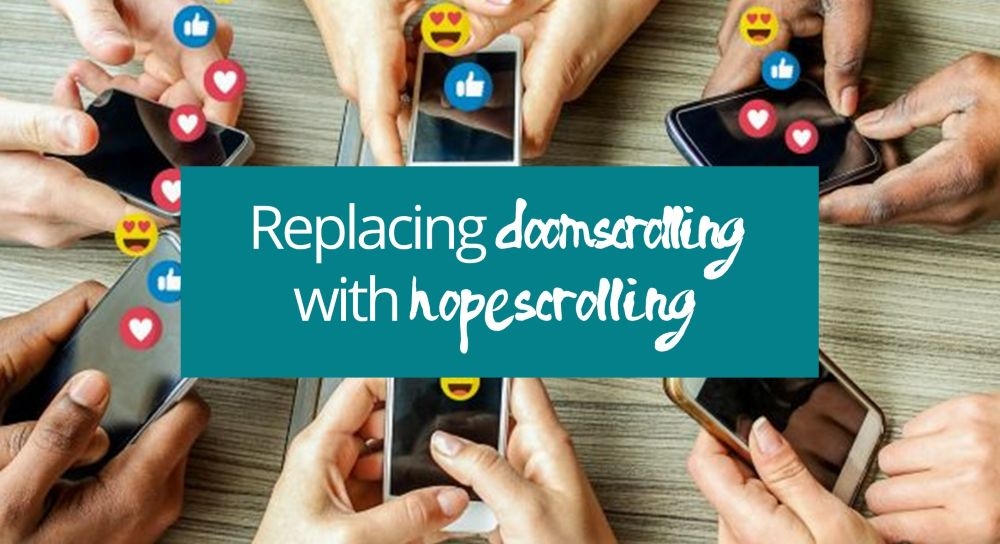Replacing Doomscrolling With Hopescrolling

In today’s world, it’s easy to instinctively scroll through endless feeds of distressing headlines and negative news. The term “doomscrolling” emerged to describe this compulsive consumption of pessimistic content online. It’s the act of continuously scrolling through bad news, often leading to heightened anxiety, stress and a sense of helplessness.
In contrast, a growing movement is encouraging a shift toward “hopescrolling,” which is the intentional act of seeking out uplifting, inspiring and solution-oriented stories that foster optimism and resilience.
Healthline defines “hopescrolling” as “the act of deliberately searching for and consuming positive content that may feature acts of kindness, uplifting stories, art, humor, coziness, self or community improvement, the beauty of nature, etc.”
By replacing doomscrolling with hopescrolling, digital habits can be reshaped to support mental well-being and cultivate a more hopeful outlook about the world. This SSG Health+Wellness Insight highlights hopescrolling and ways to replace the unhealthy habit of doomscrolling with mindful media consumption.
Why People Scroll
The average American picked up their phone 205 times per day in 2024 and spent an average of about five hours per day on their phones. That’s a total of almost 2.5 months spent on the phone. Considering this significant amount of time, it’s important to be cautious about how you’re spending that time on screen.
The brain is wired to seek information, especially information that might help you survive. This is why negative news grabs your attention. It feels urgent, important and hard to ignore. Add to that the infinite scroll of social media platforms designed to keep people engaged, and you’ve got a recipe for compulsive behavior.
In general, people scroll on devices because:
- They crave connection. Social media offers a sense of community and belonging.
- They seek control. Staying informed can feel like a way to manage uncertainty.
- They want to be in the know. People often try to keep up with the news or other timely developments so they’re well-informed.
- They’re bored or anxious. Scrolling often becomes a coping mechanism or distraction.
- They’re addicted to the novelty. New content triggers dopamine, which is the brain’s reward chemical.
Although scrolling is a common behavior, constant exposure to negativity can lead to burnout, anxiety and even depression. That’s where the practice of hopescrolling comes in.
Techniques for Mindful Media Consumption
You can start small by replacing the unhealthy habit of doomscrolling with hopescrolling. Consider the following tips to be more intentional while scrolling:
- Follow positive accounts. Curate your social media feeds to include more positive content by following users who share happy news and funny, lighthearted videos. Additionally, unfollow or mute sources that consistently leave you feeling drained or hopeless. Strive to consume content that nourishes and uplifts you.
- Set a time limit. To reduce the time you spend scrolling, set a timer or utilize your device’s app limits feature. It’s important to take regular breaks to reset your focus. Even a 10-minute walk or a few deep breaths can help you re-center.
- Set intentions before you scroll. Ask yourself: Why am I opening this app? Is it to connect, learn, relax or distract? Setting a purpose helps you stay mindful and avoid falling into a doomscrolling spiral.
- Consume content with purpose. On a similar note, identify what you specifically want to do, find out or understand better. It’s still valid to want to consume the news, and having a purpose or goal can help keep your scrolling on track.
- Remove apps. If you find yourself upset or in a bad mood every time you use a specific app, try deleting it from your device and replacing it with an app that improves your mood instead.
- Manage notifications. Change your phone settings to reduce the number of notifications you receive daily. They can often deliver upsetting and distracting news, and it can be tempting to start scrolling every time you get a new one.
- Practice gratitude. After a hopescrolling session, take a moment to reflect on what you learned or felt. Write down one thing that gave you hope. This practice reinforces positive habits and helps shift your mindset over time.
Even if you only replace doomscrolling with hopescrolling a few times each day or week, that is still an improvement. Mindful media consumption will become more natural over time as you continue to practice.
Summary
Consuming a constant stream of negative news without pausing can be detrimental to your mental and physical health. It’s essential to cut back on doomscrolling to give your mind a break. If you or a loved one is having difficulty breaking the doomscrolling habit, consider reaching out to a mental health professional who can offer guidance and support.
Strategic Services Group (SSG) Benefits Advisors are ready to help employers shift to a strategic, end-to-end cost management approach—one that prioritizes long-term planning, accountability, and innovation across every facet of the benefits program.

 Prev
Prev

